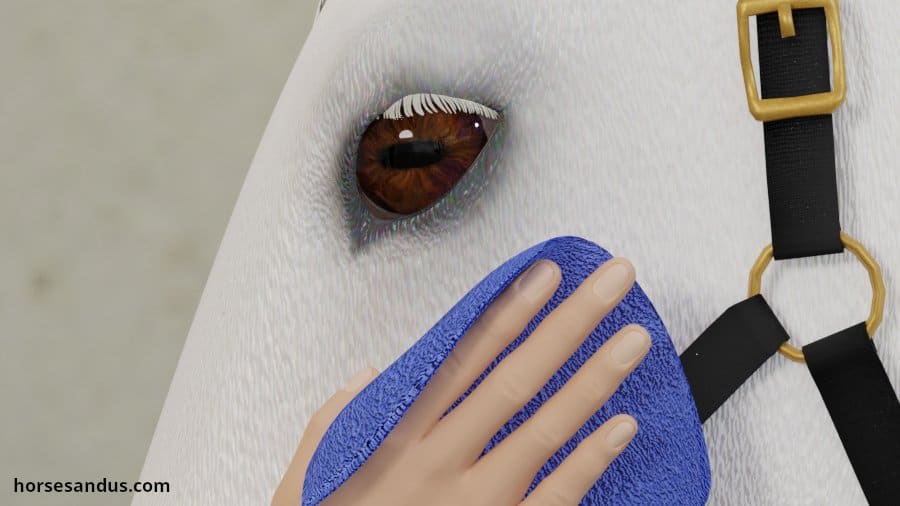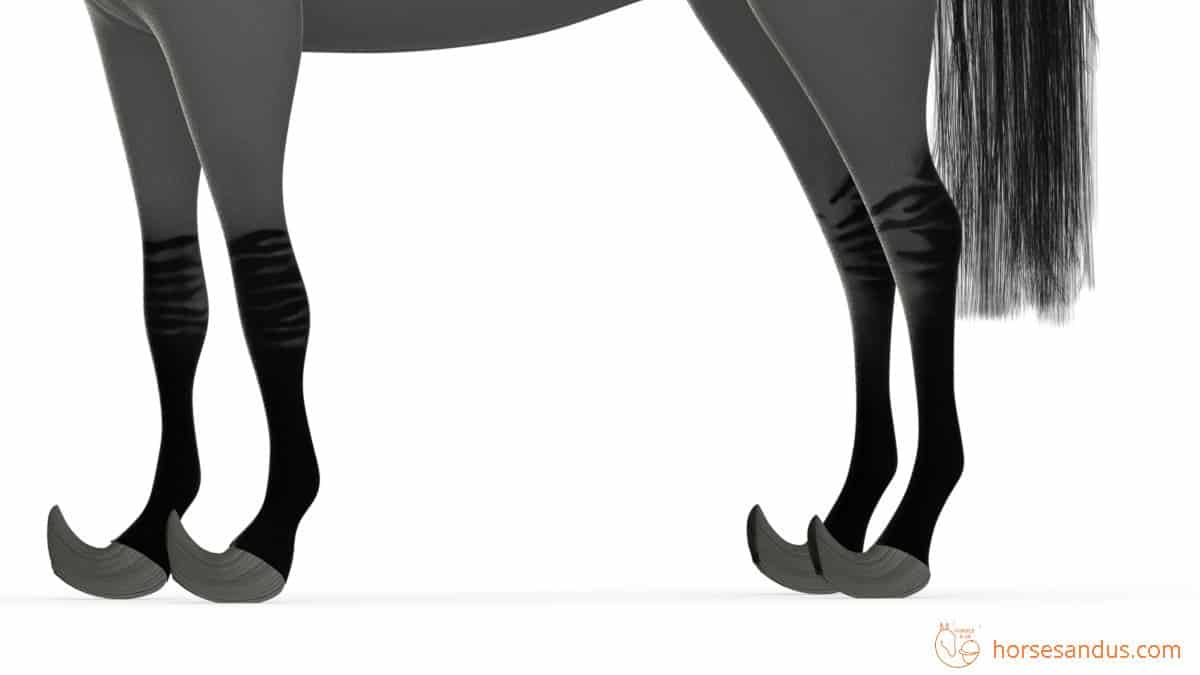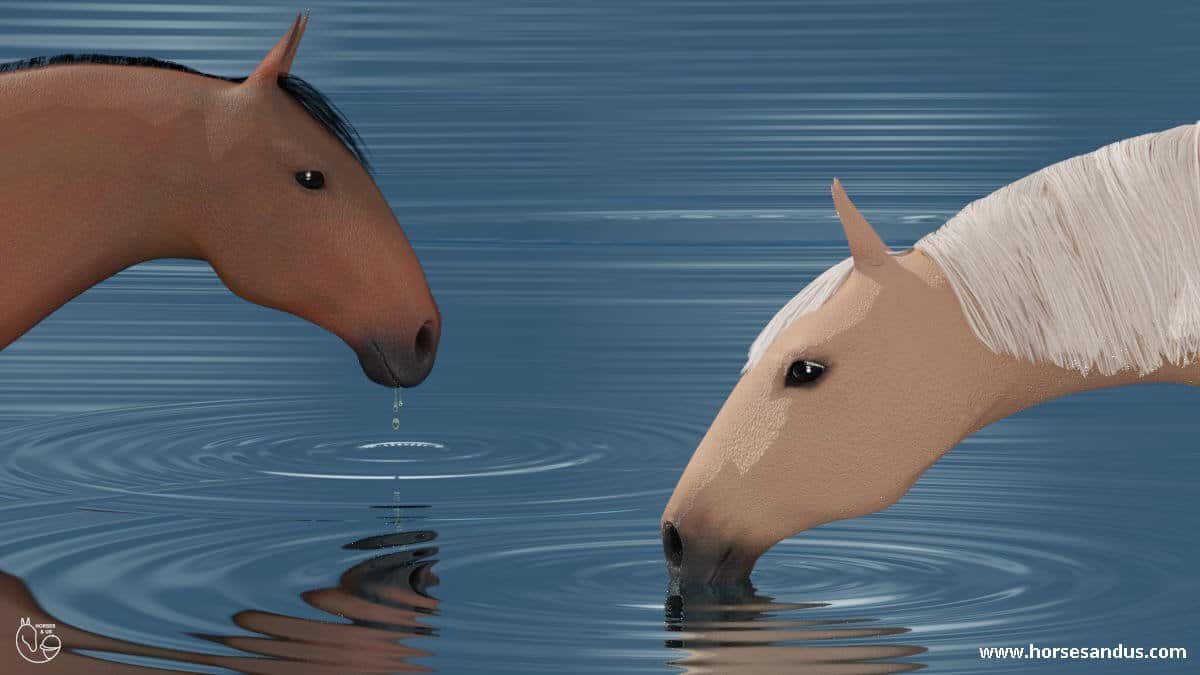When you think about what it takes to shoe a horse: sharp tools, nails, hot metal… you can easily believe that it will hurt the horse.
Shoeing a horse using hot metal and nails does not hurt the horse if it is done correctly. But… maybe sometimes it can hurt. We will see why in this article.

Horseshoes are attached to the hoof with nails. The nails are driven into a tough part of the hoof, called the hoof wall, which is completely insensitive. So the horse doesn´t feel any pain when these nails go through the hoof.
But… the nails must be placed with care so they don´t touch living tissue.
Hot metal shoes are placed in contact with the hoof to help get a leveled hoof that will hold the shoe much better. When the hot metal touches the hoof, a lot of smoke comes out, and a strong smell of burnt hoof, which can look like it is hurting the horse. However, also, in this case, it doesn’t hurt due to the insensitive hoof wall.
But… the hot shoe should barely touch the hoof and should be removed quickly. Care should be taken not to produce sores in the hoof.
Why is the Hoof Wall Insensitive?
The hoof wall is made of a tough protein called keratin, which is not living tissue and therefore has no blood and nerve supply. It is the same as our fingernails, which are also made of keratin.
Think about how you can trim your fingernails without feeling any pain. It is the same with the hoof walls.
However, the hoof is made of multiple layers of keratin, making it very strong and thick. This is why it is possible to put nails into the hoof walls without the horse feeling any pain.
To understand why shoeing a horse is painless and why sometimes it can be painful, you need to know some basics about the hoof anatomy and the procedure used to shoe a horse.
Horse Hoof Anatomy
All the parts of a horse have a purpose, and the hoof is crucial, playing a key role in the horse’s ability to survive and function. The adage “no hoof, no horse” underlines this fact.
The horse’s hoof is very complex. It is made up of several parts, each with a different purpose but all working together in sync to keep the hoof healthy and functioning.
The hoof is made up of an external part (the hoof capsule) made of hard keratinized tissue and an internal part made of soft living tissues and bone.
External Parts of the Hoof
Hoof wall
This is the hard, outer covering, which has several functions:
- Protects the sensitive internal parts
- Supports the weight of the horse
- Absorbs the shock as the hoof lands on the ground
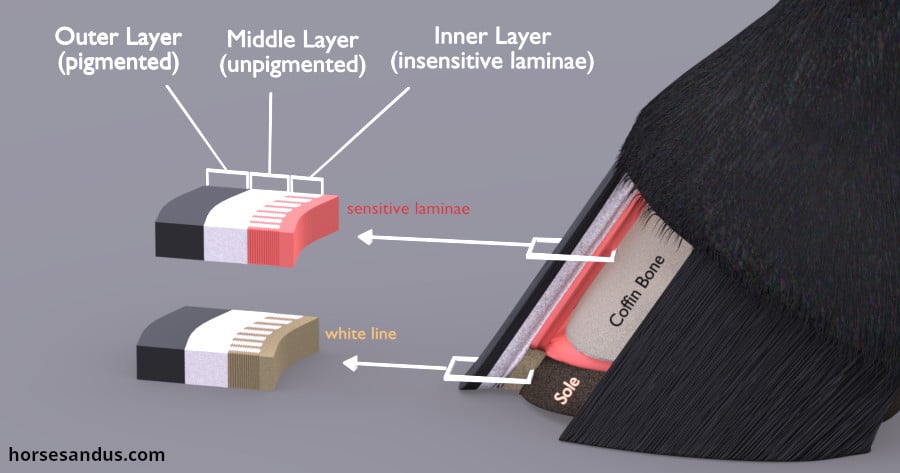
The wall has 3 layers: the outer layer, which is pigmented, the middle layer, which is white and is also called the water line, and the inner layer, composed of insensitive laminae.
The outer layer is a strong structure and has the main role of protecting the hoof´s inner parts and supporting the horse’s weight.
The middle layer is unpigmented, and it is more malleable than the outer layer because it has more moisture. Its function is to support the weight and absorb the shock when the hoof hits the ground.
The inner layer is a semi-rigid structure connecting the hoof wall to the sole and the coffin bone.
The Inner layer consists of insensitive laminae material (with no blood supply or nerves) which interdigitates with other tissues, binding like Velcro to establish junctions:
- Coffin bone / Wall junction – The insensitive laminae interdigitates with the sensitive laminae (with blood supply and nerves) that surrounds the coffin bone.
- Sole / Wall junction – The insensitive laminae interdigitates with the “white line” adjacent to the sole.
The name “white line” is misleading because this line is actually yellowish. Sometimes it is called the “golden line.”
Underneath the hoof, it can be seen as a thin yellowish line between the sole and the hoof wall. Sometimes it is misinterpreted with the middle layer or water line, which is actually white.
The white line should not be penetrated by a nail when shoeing the horse.
Looking at the hoof from underneath we can see the following parts:

Sole
The sole is a concave area under the horse´s hoof surrounded by the white line, the bars, and the frog. Most of it does not have contact with the ground.
It is thick and protects the coffin bone from injury when the horse travels on rough terrain or steps on hard objects.
Frog
The frog is one of the most important structures of the horse´s hoof. The frog is a V-shaped leathery tissue underneath the hoof and should have full contact with the ground.
It has many functions: it protects the hoof parts beneath it, provides traction, assists blood flow, and absorbs shock.
Bars
The Bars are a continuation of the hoof wall, which turns at the heels, runs along the frog’s side, and merges into the sole approximately halfway down the frog.
Their main function is to add strength to the heel area, protecting it and allowing it to expand upon impact.
Internal Parts of the Hoof
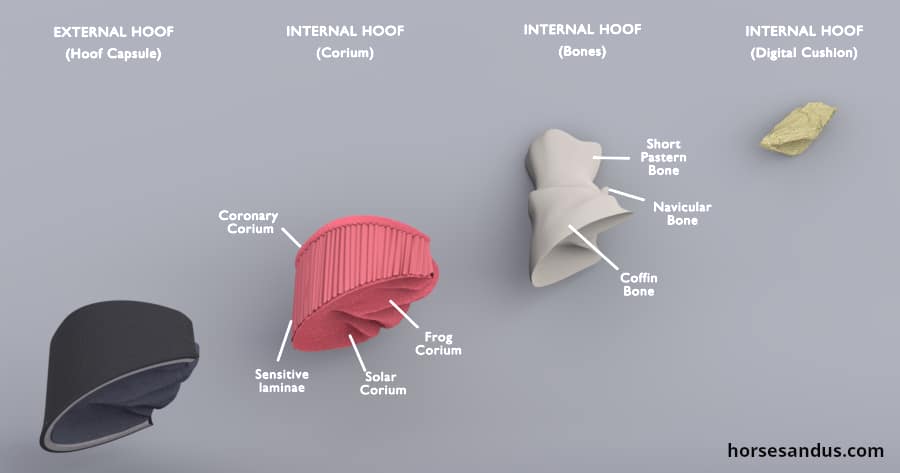
Bones
The bones of the horse hoof are:
- coffin bone (third phalanx) has a shape that mirrors the foot capsule
- navicular bone
- short pastern bone (second phalanx) only the bottom portion of this bone extends into the hoof
Corium
Corium is a vascular structure that produces hoof horn tissue. Inside the horse hoof, there are several areas of corium.
- Dermal layer or sensitive laminae, which surrounds the coffin bone and produces the insensitive laminae of the inner hoof wall. These two laminar bind together like Velcro connecting the hoof wall to the coffin bone.
- Solar Corium, which produces the Sole
- Frog Corium, produces the Frog
- Coronary Corium which produces the outer layers of the hoof wall.
Digital cushion
The digital cushion is a wedged-shaped and very elastic structure, which sits behind the coffin bone and above the frog. It has a crucial role in the absorption of shock.
The horse shoeing procedure
The horse needs to be shod regularly, every four to six weeks because, during this time, the hoof is growing and will need to be trimmed even if the shoes are still in good condition.
Horseshoeing is a process in which a farrier applies horse shoes to the hoof.
Horse shoes are commonly made of steel, but can also be made of aluminum or other material.
The horseshoe is usually applied by fixing it to the hoof with nails. The nails are driven into the wall in an oblique direction.
They enter the wall at the outside edge of the white line (not into the white line) and they emerge at the wall´s surface up the hoof.
There are two variations of this process: hot shoeing or cold shoeing.
Horse Hoof Hot Shoeing
In hot shoeing, the old shoe is removed, and the hoof is trimmed. Then a new shoe that suits the hoof is selected.
Steps for Hot Shoeing:
1. The shoe is then heated in a forge so it can then be molded to the correct shape for the hoof.
2. To obtain a perfect leveled fit, the hot shoe is lightly placed onto the hoof. This will burn the wall’s insensitive structure and leave burned marks that will clearly identify uneven areas. These marks will then guide the farrier to level the hoof and mold the shoe for a perfect fit.
3. After the shoe is molded into the correct shape, it is cooled down and then nailed to the hoof.
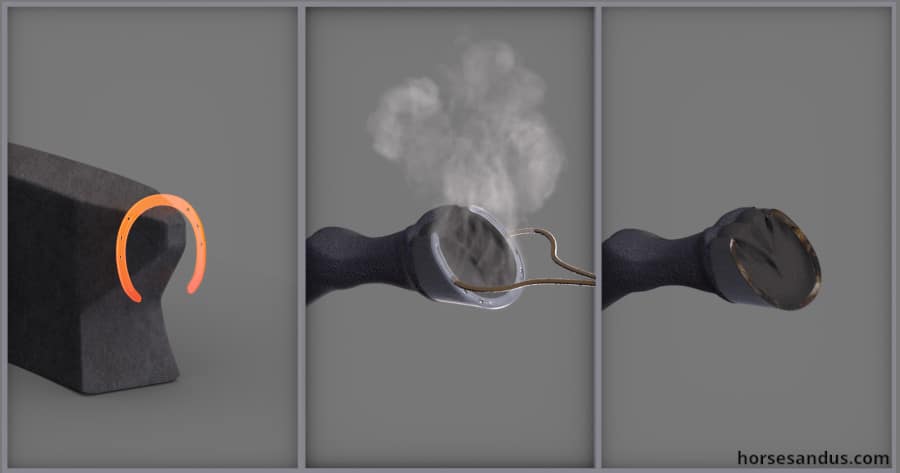
Horse Hoof Cold Shoeing
In Cold Shoeing, the old shoe is removed, and the hoof is trimmed. Then a new shoe with the correct shape is selected.
Steps for Cold Shoeing:
1. The shoe is molded to fit the hoof. The cold shoeing procedure makes it more difficult to match the shoe to the hoof because the shoe’s molding is harder with cold steel. Also, obtaining a perfect leveled and balanced hoof that fits the shoe is more difficult without the aid of the burned marks used in hot shoeing.
2. After the shoe is molded into the correct shape, it is then nailed into the hoof.
Horseshoeing is not a painful process because it only touches the insensitive structures of the hoof wall. However, sometimes there can be problems with this process that can cause very painful situations for the horse.
The most common situations are Nail Pricking or binding, Corns, Contracted heels, and Cracked hoof heels.
Nail Bind and Nail Prick
Nail Bind and Nail Prick are painful situations in the hoof that can arise when the nails are misaligned and therefore come close or penetrate the hoof’s sensitive laminae.
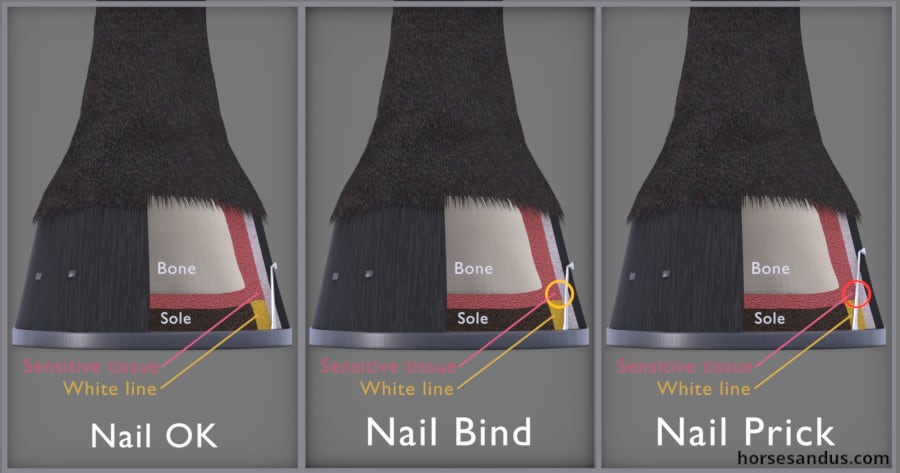
Nail bind or close nail
Is when the nail goes very close to the sensitive laminae of the hoof. This will consequently cause pressure on the sensitive area when the horse puts weight on the hoof.
After a day or two lameness will arise as a result of infection and inflammation.
Nail Prick or Quickening
Is when the nail has penetrated the sensitive tissue. This usually causes immediate lameness and is very easily diagnosed.
The shoe should be removed right away before infection and inflammation appear.
Causes of Nail Bind and Prick
- Incorrect placement of the nail.
Placing the nail correctly is very important. It should be placed deep enough to hold the shoe securely and thus avoid splitting the hoof, but not too deep that the sensitive tissues may be impacted, leading to painful situations.
The white line should be the guide. The nail should enter the hoof wall on the outer edge of the white line.
- Excessive clinching of the nails.
This can cause an inward bending of the nail, placing it too close or even touching the sensitive tissue.
- A slight displacement of the shoe.
Can cause the nail to put pressure on the sensitive tissue
- Horses that have thin hoof walls .
- Horses that are nervous and move during the shoeing process.
Symptoms of Nail Bind and Prick
The main symptoms are lameness due to the pain, warm foot, and increased pulse if an infection has set in.
Bruised Sole and Corns
Poor shoeing can increase the risk of bruising around the outside edge of the sole or at the toe.
A Corn is a deep tissue bruise that forms between the sensitive and insensitive layers of the foot’s sole. It appears in the area of the sole where the heel and bars meet. This area is called the “seat of corn.”

Causes of Corns
Corns are often due to improperly fitted shoes that are too small and tight at the heels. This causes pressure and consequent traumatization of the “seat of corn.”
They can also be caused when the horseshoes are left on for too long. Therefore, as the wall grows, the shoe is carried forward, causing the shoe branches to traumatize the “seat of corn.”
Lameness often occurs for some time until the corn grows out and becomes visible.
Symptoms Of Corns
The main symptoms are a shortened stride due to the toes contacting the ground to save the heels, lameness that is increased on hard ground or when circling, and a warm hoof.
Contracted Heels
Contracted heels are characterized by a narrow hoof and where the quarters and heels are drawn in. The heel bulbs and the frog are narrow and shrunken, and the sole is more concave.

Causes of Contracted Heels
Among other causes we have the following:
Incorrect trimming of the hoof creates imbalances such as the heel too low and the toe too long, which can cause heel contraction.
Improper shoeing that draws in the quarters will prevent a healthy hoof expansion and lead to contracted heels.
Symptoms of Contracted Heels
The entire hoof is narrowed, the sole is concave, and the frog is atrophied. The heel bulbs are also compressed.
With all these parts of the hoof affected, their functions are not performed adequately, and consequently, problems in the hoof and pain start to appear.
Cracked hoof heel
These hoof cracks occur at the back of the hoof, below the heel bulbs. These cracks can be very painful.
Causes of Cracked Hoof Heel
Besides many other things, the cracking at the heel may be caused by improper shoeing:
- A small and tight shoe. In this case, the shoe does not cover the horse’s heel. Therefore the portion of the heel that is left overhanging may split vertically.
- A long shoe with excessive shoe length can result in excessive pressure in the heel wall, causing the hoof to crack there.
Symptoms Of Cracked Hoof Heel
This situation is painful and can lead to lameness.
Do Wild Horses Need Shoeing?
The answer is no. Wild horses don’t need shoeing because of two main reasons:
- They walk long distances, 20 to 40 miles (30 to 60 km) a day, over rough terrains, which creates tough hooves that dont´s need shoes.
- They have genetically healthier hooves because natural selection will only select the more robust horses that can survive in the wild.
Check our article about how wild horses maintain their hooves if you are interested in knowing how they manage to do this.
Further reading
To learn more about horseshoeing, check out the american farriers site which has many interesting articles on horseshoeing.
